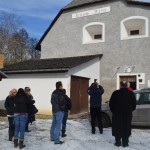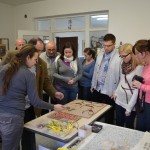The second visit in the Czech Republic took place from 13th March till 15th March 2013. The visiting delegations consisted of four representatives from Slovakia and five persons from Poland. The Dutch partner didn’t have its representation. The project group of the hosting country consisted of people from the hosting organisation LAG Strakonicko and its partner Association of Regional Brands.
Programme:
Wednesday:
- Arrival and accommodation at Penzion Mlýn Kostřata
- Welcoming dinner
- Introduction of the project, presentation of the regional brand from Prácheňsko region, presentation of activities of the project partners and participants in their regions
- Discussion about practical experiences related to the labelling of local products
Thursday:
- Visit of a family mill with a touristy potential at the village Závišín u Bělčic
- Visit of a glass manufactory at Bělčice
- Lunch at Blatná
- Discussion about the visited mill
- Visit of a ceramic manufactory, its shop and accommodation facility in Strakonice
- Dinner at the Strakonice castle
Friday:
- - Workshop about regional branding – presentation of the system of the regional branding in the Czech Republic
- - Presentation about typical folk architecture of the South Bohemia region
- - Evaluation of the visit
- - Lunch
- - Departure
The main programme of the visit took place at Penzion Mlýn Kostřata which is one of the holders of the regional brand Prácheňsko regional product dedicated to to tourist services. The participants had the chance to test a typical local accommodation as well as a home-made food there.
Labelling of local products at Prácheňsko region
The experiences of the coordination of the regional brand at Prácheňsko region were presented by Iva Chládková from LAG Strakonicko (www.strakonicko.net). The aim of the local branding is mainly to support local producers, the preservation of traditional crafts in the region and to make visible the former historical territory of Prácheňsko.
Within the almost three years of ongoing labelling project there are more than seventy products and services awarded with the regional brand Prácheňsko regional product. You can find variety of crafts from typical hand crafts as lace or ceramics, to farming products as milk and meat and finally also the accommodation and catering services among them.
The brand serves as a marketing tool for the local producers, but it also provides the opportunity for mutual cooperation among producers (as also the good practice from Polish brand Barycz Valley Recommends showed). The other added value of the brand is the organization of common events where producers can present and sell their produces. In this region, the special exhibition stands in the style of typical local architecture were made. They are used for fairs or other special events of the brand, e.g. for ceremonial events at the castle courtyard in Strakonice or for fairs throughout the region.
Each region has its specifics (first visit evening there were presented experiences from the Polish region of Barycz Valley and Slovak Kopaničiarsky region and Podhoran), but all these regions have their local producers or farmers contended with similar problems, also the target groups of all mentioned local activities are very similar.
The case study of the family mill
The first site visit was in village Závišín, where the participants could take a look to a family owned water mill. Prior to the visit the participants were given some fact about the mill by Martina Kozáková who worked out on the business vision of this mill.
The building lost its original function so the question is what to do with it now. The mill has a major in rural tourism thanks to its history which dates back to the 16th century and which is connected with famous Czech painter Mikoláš Aleš and his family. On the other side the building itself was significantly changed during frequent rebuilding and reconstructions.
A part of the mill has being rebuilt by self-help to a relaxing facility since 2002 (after a destruction by flood). For holidaymakers there is one big passable room offering an overnight stayfor a large group of people. There is also a meeting room with a billiard table and a private wine bar available. Some of rooms are still under a reconstruction. In the mill there are preserved also some of original milling tools.
The outside area of the mill has a great potential for another use as e.g. farming place, ponds with carps, beekeeping … It can be use also for demonstrating and learning of traditional craftis and farming.
The participants of the visit discussed the current situation of the mill and tried to seek for options of its use. The want of money, lack of visions and not always sensitive reconstructions were appraised as the main problems of the place. Among the proposals there were some ideas how to continue: to stress the connection to the famous painter, to direct on group of young people or people who want to experience farming life, to create a clear vision of the rebuilding and create a house in a specific but united style.
Glass manufactory at Bělčice
Next stop was at a glass manufactory (www.sklarnabelcice.cz) owned by Mr. Vlasák and his family located at a village called Bělčice. The products from this glassworks have the certificate of the local regional brand. You can find here the replicas of historical glass from ancient times to Renaissance. Glass products are made by traditional handmade technology. Participants could speak with the glassmaker right during his work so they could also see the procedure of the glass making. Besides of producing methods there were questions about promoting and marketing. They offer their good through an e-shop but many costumers use it only as a catalogue but they usually prefer to go directly to the manufactory and buy there pieces that they could see and hold in their hands. And it is not only the case of people from the surrounding but most of customers are coming from bigger cities often even quite distant. There could be also possibility of some workshops for children or adults but the procedure is quite dangerous so it can be use only as a presenting of the manufactory.
Ceramic manufactory in Strakonice
Another holder of the regional brands who participants could meet was Mrs. Laiblová and her company UMKERA (www.umkera.cz) with more than twenty years of history. Her company has revived tradition of ceramic buttons. These buttons are made by traditional technology but with contemporary design and they are created mainly for original fashion manufactories, knitters or also for individual customers who want to enrich their clothing. The owner showed to the participants not only the production itself but also spoke very interested about development of the demand, export to distant countries or presence on the foreign ceramic festivals. She also emphasized the importance of the regional brand for her.
Just next to this manufactory there is her shop with ceramic buttons and jewellery. It is also used as a selling gallery for other art products. Participant had also chance to see accommodation which is provided by her and which will be soon judge by the certification committee for the services to awarding the regional brand.
Dinner at the restaurant with regional brand
At the end of the day, participants could try the other regional product with all
their senses. They had dinner at restaurant called “Hradní sklípek” which is situated right at the castle in Strakonice and which was also awarded by the regional brand.
Workshop about regional branding
Kateřina Čadilová, the national coordinator of the Association of Regional Brands
(www.regionalni-znacky.cz), presented the system of regional branding in the Czech
Republic, where are nowadays involved 23 member regions. In all these regions there are regional brands for local products, which guaranteed not only the quality of the products and their consideration to the environment but mainly their origin in the region and some specific relations with the place. In present there are more than 600 valid certificates nationwide.
The Association of Regional Brands coordinates the system of the regional branding on the national level. The whole system is unique both with united criteria for awarding the brand certificates and for its united graphic style. The logos of particular regions have similar layout but vary in the main symbol based on something typical for the particular region. This is something what is quite unparalleled within Europe. Of course there are also some problems mainly related to the insufficient financing and differences in particular regions and their approaches to the branding initiative.
Under the national coordination there were created some common promotional materials, e.g. common website, newspapers or leaflets. Also some common events were organised, e.g. crafts fairs in Prague. The main responsibility of the association is to keep the unified rules and coordinate all the regions. The national coordinator supervises coordinators in regions, attends all certification committees, and seeks ways of efficient promotion of the system since the beginnings of the establishment of a new brand.
Typical folk architecture in the South Bohemia
The last presentation was dedicated to the local folk architecture that is seen as a very important and typical feature of this region that the participants could see during of the whole staying there. The presentation was made by Pavel Bureš, who is a specialist in the field of the folk architecture and historical rural settlement at the National Heritage Institute. He showed the examples of the typical houses in the region and also spoke about the problems connected with the maintenance of the historical and cultural monuments. The typical architecture style for this region is called “Rural Baroque” mainly from 19th century. It is a specific style of rich rural buildings from that quotes some baroque and classic features but it is very specific for the South Bohemian region. One of the best examples of these buildings you can find at the village Holašovice, which was designated as a UNESCO World Heritage Site in 1998.
Report from the visit (PDF)










